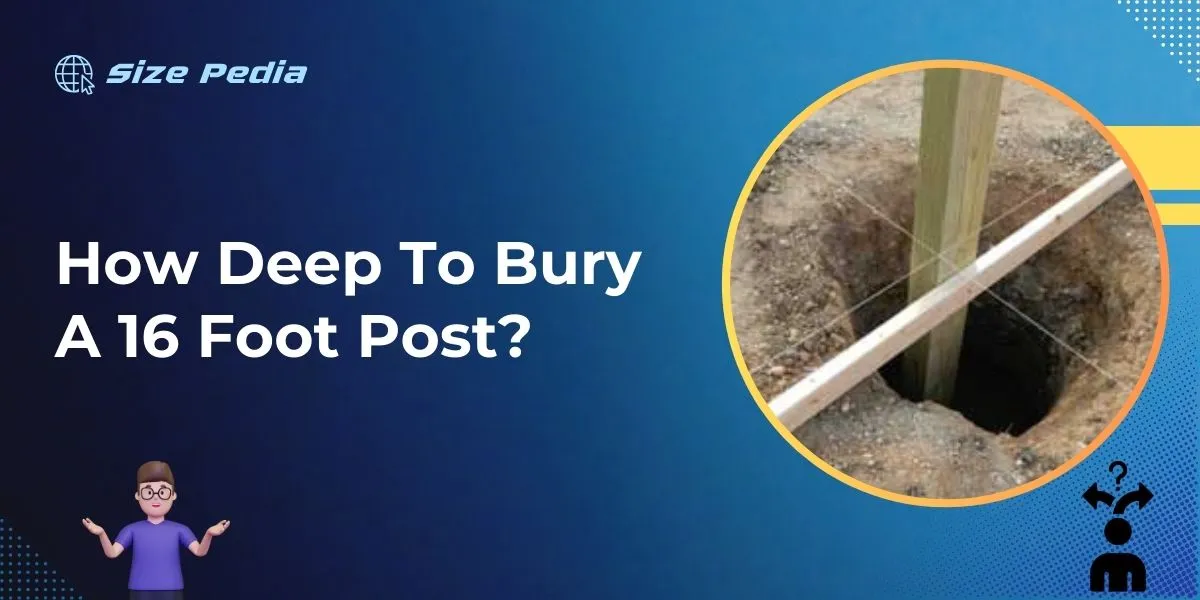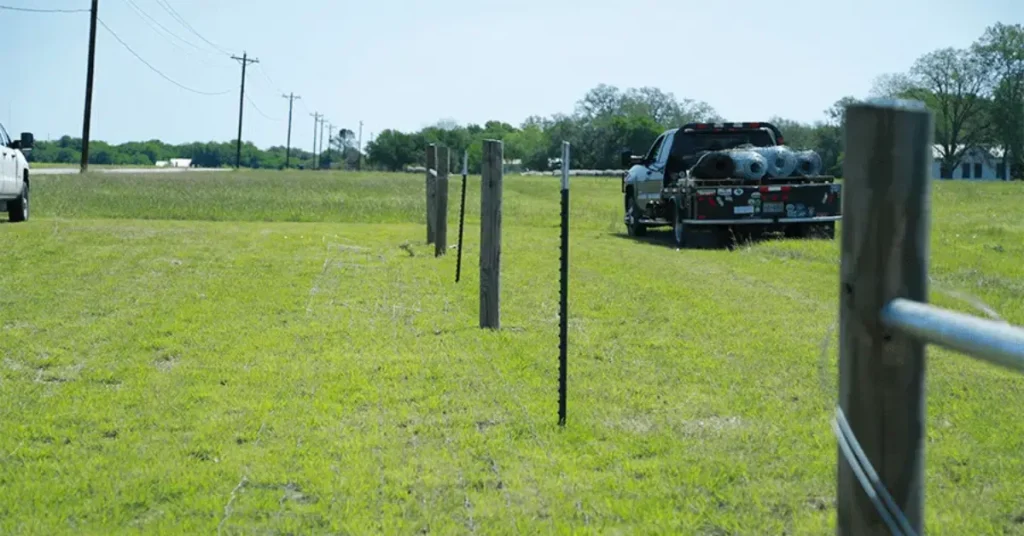Bury a 16-foot post at least 2-3 feet deep to ensure stability. Use one-third of the total length as a general burying depth guideline.
Installing posts for a structure or fence requires precision and understanding the depth necessary for stability and durability.
A 16-foot post, commonly used for fences, flagpoles, or construction projects, must be buried properly to withstand environmental stress and load-bearing demands.
The depth will depend on local building codes, soil type, anticipated load, and climate conditions, including frost lines.
A secure installation begins with digging a hole that accommodates the post’s size while also aligning with best practices, such as using one-third of the post’s length as a starting point for the depth.
This critical step lays the foundation for whatever structure the post will support, ensuring it can endure for years to come.

Selecting The Right Post Depth
Securing a 16-foot post starts with the right depth. Depth affects stability and durability. It resists wind and weight. This guide helps choose the correct depth for a strong foundation.
Local Building Codes Considerations
Local regulations guide post depth. They keep structures safe. Always check these before digging:
- Depth requirements: Varies by area.
- Frost line: Posts should sit below this line.
- Permits: Some areas require them for digging.
Contact local building authorities before starting. They provide specifics for your location. This ensures compliance and safety.
Soil Type And Post Stability
Soil type influences post depth. Different soils have unique characteristics:
| Soil Type | Characteristic | Suggested Depth |
| Clay | Holds moisture, less stable | Deeper than 1/3 of post |
| Sand | Drains well, shifts easily | Deeper than 1/3 of post |
| Loam | Balanced, more stable | At least 1/3 of post |
Perform a soil test. Determine the soil type on your property. Adjust the depth based on your findings. Aim for stability to prevent leaning or collapse.
The Rule Of Thirds In Post Burying
When we talk about erecting a sturdy post, we can’t skip the ‘Rule of Thirds’. It’s a simple principle. Deep burial equals strong support. Follow this rule, and your 16-foot post will stand firm.
Understanding The Rule
The ‘Rule of Thirds‘ is straightforward. Take the length of your post and divide by three. The result is your burial depth. For a 16-foot post, that’s roughly 5 feet underground.
This rule ensures that one-third of the post anchors below the surface, creating a solid base. Stability comes from this deep-set foundation.
Exceptions To The Rule
Sometimes, a post needs unique treatment. Here are those exceptions:
- Heavy Loads: Increase depth for more support.
- Soft Soil: Go deeper in loose conditions.
- High Winds: Extra depth combats forceful gusts.
All these conditions mean tweaking the burial depth.
Step-by-step Guide To Burying A 16 Foot Post

Building a solid structure starts with a strong foundation. Those planning to erect a 16-foot post face a crucial task: burying it deep enough. This guide details a reliable method for installing a sturdy post.
Measuring The Correct Depth
Appropriate depth is key to a secure post. Follow these steps:
- Measure the post height. A 16-foot post requires attention.
- Divide the height by 3 to find the bury depth.
- Mark 5 feet 4 inches on the post. This mark indicates ground level.
Digging The Post Hole
Dig a hole that ensures stability.
- Use a post-hole digger for a precise hole.
- Make the hole three times wider than the post.
- Check for utility lines.
- Shovel out to the proper depth, around 5 feet 4 inches.
Securing The Post In Place
Stabilize the post with concrete:
| Position the post | Center it in the hole. |
| Mix concrete | Follow instructions on the bag. |
| Pour concrete | Fill around the post. |
| Level post | Use a level tool. |
| Support post | Brace it until the concrete sets. |
Check the post for straightness often. Allow concrete to cure for 24 hours. Your post is ready to support a structure!
Materials And Tools Required
When setting up a sturdy fence or structure, the right materials and tools are crucial. This section covers everything needed to get a 16-foot post underground securely.
From choosing the right post material to the tools for digging, follow this guide to ensure a stable and long-lasting installation.
Choosing Quality Wood Or Metal Posts
Starting with strong posts is essential for any fencing project. For wood, pressure-treated timber resists rot and pests. Look for a straight grain with minimal knots.
With metal posts, galvanized steel offers corrosion resistance. Ensure a thickness adequate for the intended weight and wind load.
- Pressure-treated wood – resists environmental damage
- Galvanized steel – prevents rust
- Concrete mix – stabilizes the post in the hole
- Gravel – for drainage at the base
Tools For Digging And Measurement
Digging the perfect hole for your post is non-negotiable. A post hole digger or an auger simplifies the process. Use a sturdy shovel to remove any loose soil.
A level and tape measure are essential to ensure accurate depth and alignment.
| Tool | Use |
| Post hole digger/auger | For creating deep, narrow holes |
| Shovel | To clear out dirt and debris |
| Level | For true vertical alignment |
| Tape measure | To gauge the hole depth |
| Wheelbarrow | For transporting materials |
Together, with high-quality posts and reliable tools, burying a 16-foot post becomes a manageable task. Your fence will have the strength it needs to stand tall for years.
Longevity And Maintenance Tips

Ensuring the longevity of a 16-foot post starts with its depth in the ground. Proper burying and maintenance can add years to its life. Let’s dive into how you can preserve the integrity of your post and stay on top of its care.
Preserving Post Integrity
Proper depth is the foundation of a long-lasting post. A general rule is to bury one-third of the total post length. For a 16-foot post, that means burying about 5 feet 4 inches deep.
This helps to anchor the post securely and protect it from winds. Using concrete when setting the post discourages rot and pest damage. Coat the section of post that will be underground with a wood preservative for an extra layer of protection.
Routine Inspection And Care
Regular checks can spot problems before they worsen. Here’s a simple checklist for your post maintenance:
- Inspect the post every few months for signs of decay or damage.
- Clean the wood to remove dirt and debris which can trap moisture.
- Reapply wood preservative or sealant annually to ward off rot and insects.
- Ensure soil around the post is firm to prevent leaning.
By following these steps, your post will stand tall and sturdy for years.
FAQs About How Deep To Bury A 16 Foot Post
How Deep Should A 16 Foot Post Be Buried?
For a 16 foot post, burying at least one-third of its length is recommended for stability. This means a depth of approximately 5 feet should suffice. However, local building codes and wind loads can affect this depth requirement.
What Factors Determine Post Burial Depth?
Post burial depth is influenced by post length, local building codes, the wind, and soil conditions. The rule of thumb is burying one-third of the post length, but these factors can necessitate adjustments to this general guideline.
Is Concrete Necessary For Securing A 16 Foot Post?
Concrete is not always necessary, but it improves the stability and lifespan of your post. In certain soils and where extra support is needed, concrete anchors the post effectively against environmental stresses.
Can Frost Lines Affect How I Bury My Post?
Yes, frost lines can significantly impact post installation. To prevent frost heave, posts should be buried below the frost line specific to your geographic area. Check with local authorities for this depth measurement.
Conclusion
Securing a 16-foot post demands attention to depth for stability and durability. Aim for a third of the length underground. Proper installation ensures longevity and safety.
Remember, local regulations and weather conditions shape precise requirements. Trust these tips to establish a sturdy foundation for your project.
Resources:
1. https://safety.fhwa.dot.gov/local_rural/training/fhwart0000/
